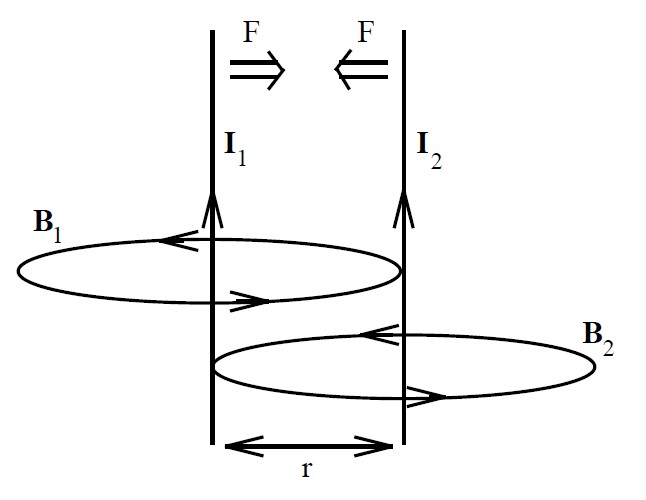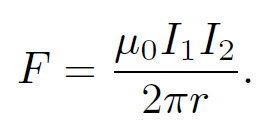
Amperes law
 المؤلف:
Richard Fitzpatrick
المؤلف:
Richard Fitzpatrick
 المصدر:
Classical Electromagnetism
المصدر:
Classical Electromagnetism
 الجزء والصفحة:
p 73
الجزء والصفحة:
p 73
 2-1-2017
2-1-2017
 3350
3350
Ampere's law
Magnetic fields, like electric fields, are completely superposable. So, if a field B1 is generated by a current I1 flowing through some circuit, and a field B2 is generated by a current I2 flowing through another circuit, then when the currents I1 and I2 flow through both circuits simultaneously the generated magnetic field is B1 + B2.

Consider two parallel wires separated by a perpendicular distance r and carrying electric currents I1 and I2, respectively. The magnetic field strength at the second wire due to the current flowing in the first wire is B = μ0I1/2πr. This field is orientated at right angles to the second wire, so the force per unit length exerted on the second wire is
 (1.1)
(1.1)
This follows from above as

which is valid for continuous wires as well as short test wires. The force acting on the second wire is directed radially inwards towards the first wire. The magnetic field strength at the first wire due to the current flowing in the second wire is B = μ0I2/2πr. This field is orientated at right angles to the first wire, so the force per unit length acting on the first wire is equal and opposite to that acting on the second wire, according to
 .
.
Equation (1.1) is sometimes called ''Ampere's law" and is clearly another example of an ''action at a distance" law; i.e., if the current in the first wire is suddenly changed then the force on the second wire immediately adjusts, whilst in reality there should be a short time delay, at least as long as the propagation time for a light signal between the two wires. Clearly, Ampere's law is not strictly correct. However, as long as we restrict our investigations to steady currents it is perfectly adequate.
 الاكثر قراءة في الكهربائية
الاكثر قراءة في الكهربائية
 اخر الاخبار
اخر الاخبار
اخبار العتبة العباسية المقدسة


